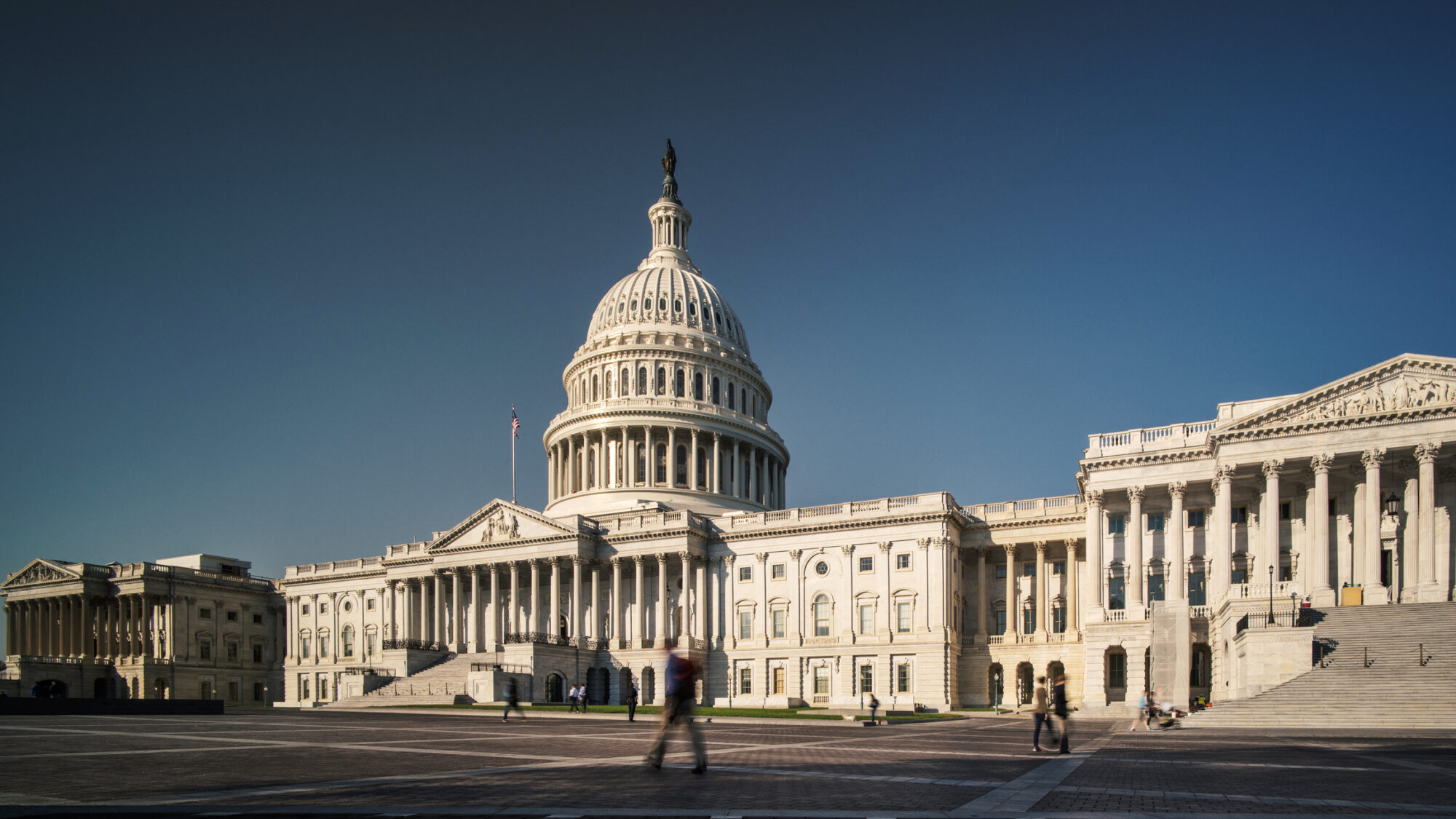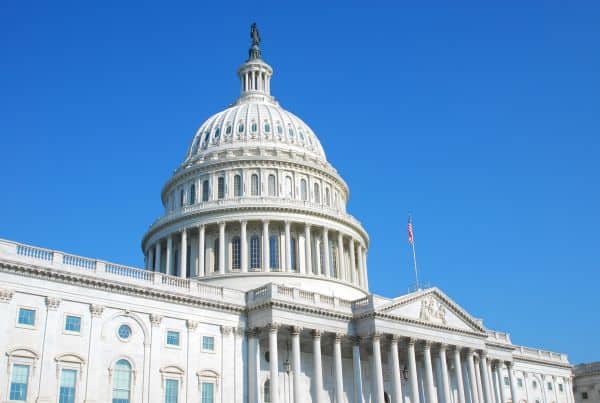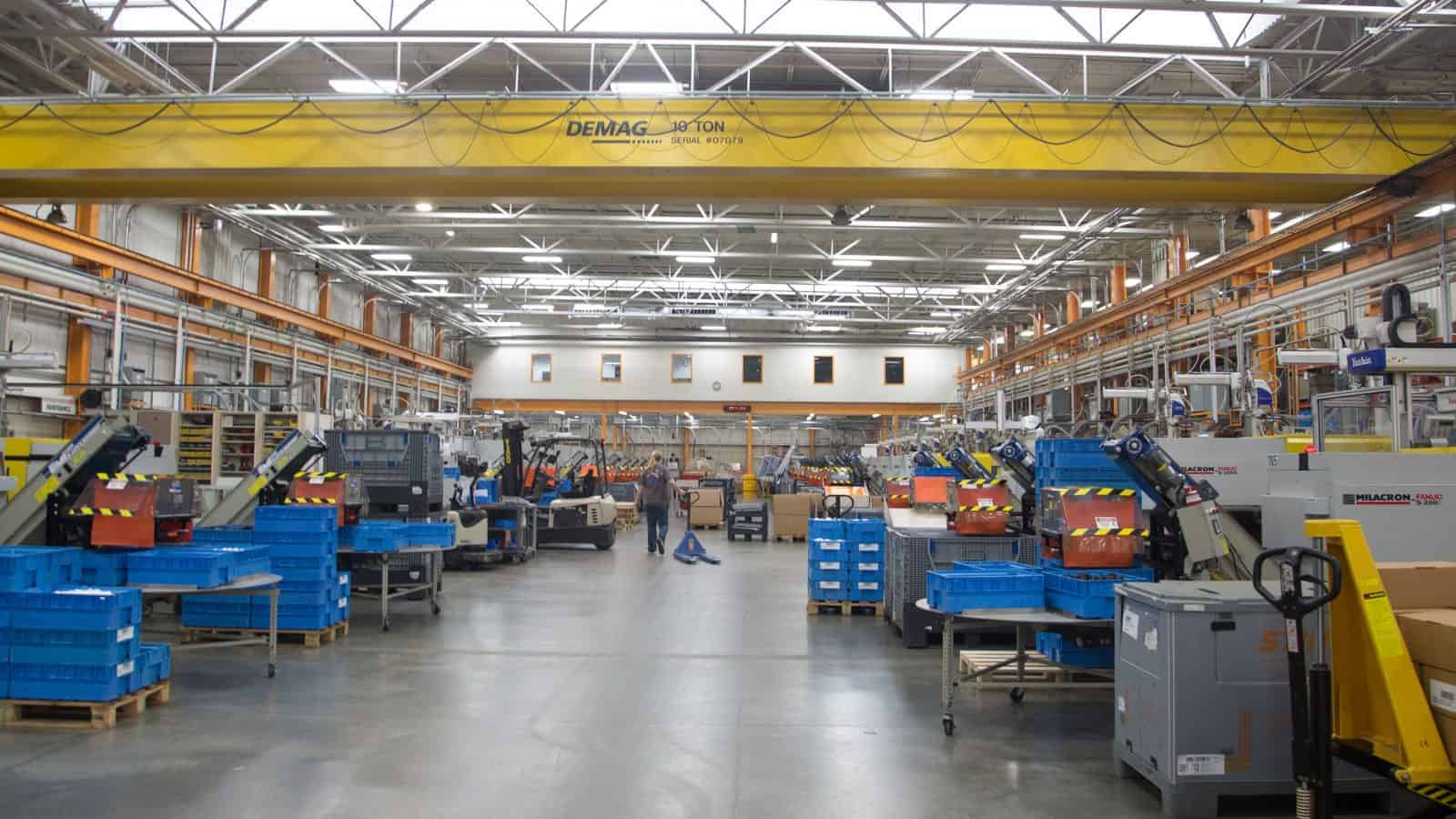Manufacturers: AI Regulations Should Support Innovation and U.S. Leadership

The introduction of artificial intelligence has been a boon to manufacturing, and the technology will continue to have a positive impact—as long as regulations are “right-sized,” manufacturers told Congress this week.
What’s going on: “Manufacturers are utilizing AI in myriad ways on the shop floor and throughout their operations,” the NAM told the House Subcommittee on Commerce, Manufacturing and Trade in a statement for the record at Wednesday’s hearing, where data was cited.
- “The diverse use-cases of AI in manufacturing suggest a need for a cautious regulatory approach to this groundbreaking technology: one that supports innovation and U.S. leadership in AI while providing context-specific, risk-based, right-sized rules of the road for manufacturers,” the NAM said.
- Giving testimony at the hearing, Siemens USA President and CEO and NAM Board Member Barbara Humpton discussed the many benefits of using AI in manufacturing and emphasized the need to ensure that AI regulations include “targeted” rather than “overly broad” definitions.
Industrial vs. consumer-focused AI: First, it’s important to distinguish between industrial and consumer-facing AI, Humpton told the subcommittee members.
- “Industrial AI is different from consumer AI,” she said. “Industrial AI uses controlled data from the manufacturing environment to help manufacturers create business value. Think better products, more efficient operations, a more prepared workforce. … AI will enable all companies—from startups to small and medium enterprises to industrial giants—to thrive in this new era of American manufacturing.”
- In written testimony, she added that “the core distinction of industrial AI is that it is trained on highly monitored data from sensors and machines, providing a more reliable foundation for training AI models.”
Simple, singular and targeted: Regulation of AI should be undertaken with a light touch and following a full accounting of on-the-books laws to prevent duplicative and/or contradictory rules, the NAM said.
- “[P]olicymakers should always review existing laws and regulations before enacting new ones, because most uses of AI correspond to tasks and objectives that industry has faced for a long time and that are thus highly likely to have already been addressed by existing laws and regulations,” said the NAM, which also referenced its first-of-its-kind AI report, “Working Smarter: How Manufacturers Are Using Artificial Intelligence,” released last May.
- “Similarly, policymakers must right-size any compliance burden associated with AI regulation,” the NAM continued. “The ubiquitous use of AI throughout modern manufacturing, as well as manufacturing’s dependence on innovation, underscore the need for rules that enable rather than hinder manufacturers’ development and adoption of AI systems.”
Protect without hindering: Congress “must advance industrial AI by prioritizing strong rules for digital trade, especially to include strong protections for source code and algorithms,” Humpton went on in her written testimony. “We encourage policymakers to build upon the success of previous U.S.-led efforts to protect intellectual property.”
- Legislators must also safeguard privacy and protect against baseless legal claims, the NAM said. “[I]t is … crucial that Congress take steps to maintain the privacy of personal data when utilized in AI contexts. … A federal standard should avoid a patchwork of state-level rules by fully preempting state privacy laws; it also should protect manufacturers from frivolous litigation.”
The last word: “The range and importance of uses of AI—transforming every aspect of the core of manufacturers’ operations—make it clear that AI has become integral to manufacturing,” said the NAM. “With the right federal policies, manufacturers in the U.S. will continue to devise new and exciting ways to leverage AI to lead and innovate and stay ahead of their global competitors.”
President Trump Reining in Regulatory Onslaught
SEC Rescinds Biden-Era Staff Legal Bulletin 14L; Action Depoliticizes Proxy Process
Washington, D.C. – Following the Securities and Exchange Commission’s rescission of Staff Legal Bulletin 14L, which required publicly traded manufacturers to include activists’ ESG proposals on their proxy ballots even when the issues raised were unrelated to their business, National Association of Manufacturers President and CEO Jay Timmons released the following statement.
“Manufacturers asked for regulatory certainty, and President Trump has delivered. Today’s action by the SEC under Acting Chairman Mark Uyeda’s leadership depoliticizes the proxy process—a crucial plank of President Trump’s pro-manufacturing deregulatory agenda.
“As we relayed to President Trump in December, SLB 14L empowered activists at the expense of manufacturers and Main Street investors—turning the proxy ballot into a debate club, forcing businesses to court controversy and divert resources from growth and value creation. Returning the SEC’s review of shareholder proposals to a company-specific process based on relevance to a business’s operations and its investors’ returns will allow manufacturers to focus on what they do best: investing for growth, creating jobs and driving the American economy.”
Background:
In December, the NAM, along with more than 100 manufacturing associations, sent a letter to President Trump highlighting more than three dozen regulatory actions across a wide range of agencies that would boost the manufacturing economy and put a stop to the regulatory onslaught that is costing manufacturers $350 billion each year, according to NAM research. President Trump began tackling these issues on Day 1, including by lifting the pause on liquefied natural gas exports. Today’s move by the SEC is another important step in the administration’s efforts to address burdensome regulations that are stifling manufacturing investment and growth
-NAM-
The National Association of Manufacturers is the largest manufacturing association in the United States, representing small and large manufacturers in every industrial sector and in all 50 states. Manufacturing employs nearly 13 million men and women, contributes $2.93 trillion to the U.S. economy annually and accounts for 53% of private-sector research and development. The NAM is the powerful voice of the manufacturing community and the leading advocate for a policy agenda that helps manufacturers compete in the global economy and create jobs across the United States. For more information about the NAM or to follow us on Twitter and Facebook, please visit www.nam.org.
SMM Chair: Extend Pro-Growth Tax Policy, Prioritize Permitting and Regulatory Reform

To lift much of the burden on manufacturers in the U.S., Congress must reinstate pro-growth tax measures, enact commonsense regulatory reforms and undertake comprehensive permitting reform. That was the main message of Click Bond CEO and NAM Small and Medium Manufacturers Group Chair Karl Hutter to legislators yesterday on Capitol Hill.
What’s going on: “American businesses now shoulder a staggering $3 trillion annually in regulatory costs—disproportionately impacting manufacturers,” Hutter told the House Committee on Small Business at Wednesday’s hearing.
- “Unfortunately, small companies get hit twice—with unworkable regulations that apply to them [and again with] compliance and reporting requirements that larger firms are forced to pass down. Fortunately, Congress and the Trump administration have the opportunity to reverse course.”
Rocket fuel for manufacturing: The 2017 Tax Cuts and Jobs Act “was rocket fuel for Click Bond,” said Hutter—whose Carson City, Nevada–based family business makes adhesive-bonded fasteners used by the U.S. military, commercial aviation industry and NASA.
- “The new 21% corporate tax rate allowed us to raise wages for production employees, invest in capital equipment, strengthen our employee tuition support program and accelerate the timeline for constructing a new facility. The new 20% pass-through deduction likewise empowered our suppliers and partners to reinvest in their businesses, readying them to support our growth.”
Changes for the worse: But growth was halted in 2022 and 2023, when provisions from the TCJA began to expire. Worse still: More pro-growth tax measures are due to expire at the end of this year—unless Congress intervenes.
- “It is now more expensive for Click Bond to conduct R&D, the lifeblood of both our product and process innovation,” according to Hutter. “It’s more expensive for us to purchase capital equipment, the tools that will unleash the productivity of our team. And it’s more expensive for us to finance job-creating investments such as that state-of-the-art, sustainable manufacturing facility.”
Ill effects: According to a recent study released by the NAM, nearly 6 million American jobs and more than $1 trillion of U.S. GDP will be at risk if Congress fails to act by the end of this year to preserve TCJA’s pro-manufacturing provisions.
What should be done: Manufacturers everywhere are struggling under the weight of both these provisions’ expiration and needless, out-of-date government requirements, Hutter went on. To fix these problems, he said, Congress should:
- Unwind “outdated chemicals reporting requirements that force us to look backward in time and deep into our supply chain”;
- Stop unnecessary permitting roadblocks by the Environmental Protection Agency at the state and local levels;
- Roll back expensive energy and labor mandates;
- Undertake “comprehensive permitting reform”; and
- Make permanent the pro-manufacturing tax provisions scheduled to sunset at the end of 2025 and bring back already expired provisions that boosted the sector and the U.S. economy as a whole.
The final say: “Congress has a critical opportunity to right-size the regulatory landscape, put an end to permitting delays and protect manufacturers from devastating tax increases,” Hutter concluded. “I encourage you to seize [it] … because when manufacturing wins, America wins.”
The Right Way to Roll Back Regs

Weeks ahead of the inauguration, manufacturers provided the Trump administration with a list of several dozen regulations that should be reconsidered or rescinded to protect manufacturers’ competitiveness. This list covered everything from power plant regulations to employment rules, and some of its recommendations have already been enacted—such as the revocation of the ban on liquefied natural gas exports, which President Trump ordered on Monday.
But signing executive orders is not enough to right-size the regulatory state and remove restrictions on manufacturers’ growth—in general, final agency rules can only be amended through notice-and-comment rulemaking. What does the administration need to do to make this rollback stick?
NAM Chief Legal Officer Linda Kelly spoke to us about the policy and legal landscape that the new administration will have to navigate.
The long term: “Manufacturers need these regulatory changes to withstand the test of time—and legal scrutiny,” said Kelly. Any changes to regulatory policy will be met with legal challenges, which will delay their benefits for manufacturers.
- The new administration needs to do everything by the book and carefully follow recent pronouncements in administrative law, or its policies will not survive, Kelly warned.
- Conducting robust cost-benefit analysis, soliciting public input and tying its actions to congressional mandates will all help the administration make its policies stick, she advised.
The legal hurdles: The big developments overshadowing this round of regulatory reform include the Supreme Court’s Loper Bright decision, which freed courts from deferring to agencies’ interpretations of statutes. Instead, the courts themselves must decide on the “best reading of a statute.”
- When the Trump administration faces judges skeptical of regulatory rollbacks and no longer obligated to defer to agency interpretation, they must come armed with well-reasoned justifications supported by data and informed by the expertise of the regulated public.
- In many cases, the NAM can provide this expertise and crucial data through the rulemaking process, and the NAM Legal Center can help defend pro-manufacturing policies by intervening in litigation and filing amicus briefs.
Agencies in need: Another new requirement for the administration emerged from Ohio v. EPA, which strengthened the requirement that agencies meaningfully respond to objections to proposed rules raised during public comment periods.
- Here again, manufacturers will play a crucial role, said Kelly, offering agencies the evidence they need to support their policymaking.
The last word: “The Trump administration has to do its homework on the front end,” said Kelly, to survive the inevitable legal challenge that will follow its regulatory changes. “Manufacturers and the NAM Legal Center stand ready to help create a court-durable regulatory environment that enables innovation and prosperity.”
The Regulatory Rollback Begins

President Trump has frequently emphasized his intention to remove burdensome regulations that weigh on manufacturers and other businesses. In his first day on the job, he took steps to set this rollback in motion. Here’s what manufacturers need to know.
Regulatory freeze: As most presidents do when they take office, President Trump imposed a freeze on new and in-process regulations.
- The freeze pauses any rules from the outgoing Biden administration that have been proposed but not finalized, finalized but not sent to the Federal Register or sent to the Federal Register but not published.
- The executive order also recommends that agencies delay the effective dates of any published-but-not-yet-effective Biden rules by at least 60 days, giving the administration time to decide whether to rescind or revise the rules.
Reinstating policies: President Trump also rescinded several of President Biden’s executive orders, reinstating policies that had been in place during Trump’s first term.
- Most prominently, President Trump undid President Biden’s rescission of his “one-in-two-out” policy, setting the stage for more reworked and repealed regulations than new rules in his second term.
- He also rescinded a Biden order that had reduced agencies’ obligations to seek public input on guidance documents, which agencies use to interpret regulations and give direction to regulated parties.
Establishing DOGE: President Trump also established the Department of Government Efficiency, which will “be dedicated to advancing the president’s 18-month DOGE agenda,” including modernizing technology and software, increasing efficiency and reducing the size of government.
- DOGE will play a role in implementing the president’s new hiring freeze: the new organization will have 90 days to work with the Office of Management and Budget and the Office of Personnel Management on a plan to reduce the size of the federal government’s workforce while the hiring freeze is ongoing.
The NAM says: “The regulatory burden facing manufacturers is sapping growth, costing the U.S. economy more than $3 trillion annually, with manufacturers shouldering $350 billion in annual regulatory costs. Small manufacturers—the backbone of our supply chain—are especially hard hit, with costs exceeding $50,000 per employee per year, or about $1 million for a 20-person shop,” said NAM Managing Vice President of Policy Chris Netram.
- “The NAM has already provided the new administration with more than three dozen regulatory actions to ease the regulatory burden on our industry.”
- “The NAM looks forward to working with the Administration to right-size the regulatory burden, providing smart, tailored rules that ensure the United States remains the best place in the world to build and create, fueling economic growth and strengthening our global competitiveness.”
Biden’s USTR Seeks to Undermine U.S. Manufacturers’ Rights

The outgoing Biden administration is undermining a U.S. manufacturer in its high-stakes dispute with the Mexican government by “seeking to erode investor-state dispute settlement (ISDS) protections under U.S. trade agreements with Colombia, Mexico and Canada,” a recent Wall Street Journal (subscription) editorial revealed.
The problem: ISDS protections safeguard U.S. investments from foreign governments seeking to interfere with or appropriate them, as the predicament of Vulcan Materials Company shows.
- Vulcan has been embroiled in a dispute with the Mexican government since 2018, when the government shut down some of its quarrying operations, according to Chairman and CEO J. Thomas Hill.
- The unwarranted shutdown forced the company to pursue arbitration under NAFTA, but the situation only got worse—former Mexican President Andrés Manuel López Obrador ordered all of Vulcan’s operations to cease in May 2022, including at a deepwater port the company built in the early 1990s.
- Now, the company is expecting its second round of arbitration to be decided by mid-2025—unless the Biden administration guts the investor protections in the U.S.–Mexico–Canada Agreement, handing a victory (and a key port) to the Mexican government.
Congressional fury: Both Congress and Vulcan itself learned of the administration’s efforts via The Wall Street Journal editorial, instead of directly from the Office of the U.S. Trade Representative. This is particularly egregious because the USTR is required to consult with Congress on investment obligations in trade deals.
- Bipartisan members of Congress have expressed their outrage, with Sen. Katie Britt (R-AL) writing in The Wall Street Journal (subscription) that “the Biden administration is negotiating away the due process of Americans, including my constituents, in the waning days of this lame-duck administration.”
- On Dec. 20, three bipartisan senators joined Sen. Bill Hagerty (R-TN) in condemning the USTR’s efforts on the Senate floor. “If Mexico is allowed to target, without repercussion, a company like Vulcan, one that employs thousands of Americans, and has operated responsibly in Mexico for decades, that means no American business is safe in Mexico,” Sen. Hagerty said.
- Sens. Tim Kaine (D-VA) and Tommy Tuberville (R-AL) joined both Sens. Britt and Hagerty in calling on Congress to pass the Defending American Property Abroad Act, which would impose penalties on Western Hemisphere countries that unlawfully seize the assets of American firms.
The NAM says: The NAM is calling on the USTR to halt this effort immediately, said NAM Vice President of International Policy Andrea Durkin.
- “ISDS has a legitimate role in U.S. trade policy to ensure our manufacturers receive fair and equitable treatment by foreign governments and to protect against egregious expropriation or nationalization of U.S. investments without adequate and effective compensation.”
- “U.S. manufacturers are entitled—at a minimum—to be consulted about any proposed changes that would impact their right to due process in ongoing cases.”
Biden Drilling Ban Sets U.S. Back

The Biden administration’s ban on new offshore oil and gas drilling in most American coastal waters “sets a bad precedent for the country,” the NAM said Monday.
What’s going on: The decision, which comes just two weeks before President Trump takes office, applies to “new drilling off the entire East Coast, as well as California, Oregon and Washington state” and “some drilling off Alaska’s coast in portions of the Northern Bering Sea and in the eastern Gulf of Mexico” (The Hill).
- Though there is currently no active drilling in the Atlantic and most U.S. offshore oil and gas production comes from the central and western Gulf of Mexico, the area placed under the ban is the largest ever “formally taken off the table for drilling by a president.”
- In response, President Trump on Monday said he would “unban it immediately” (Associated Press).
Why it’s a problem: The moratorium could prove harder for Trump to undo than other 11th-hour moves by Biden. That’s in large part because of the Outer Continental Shelf Lands Act, which gives U.S. presidents the right to block drilling in certain areas but not the right to reinstate it.
- However, Congress could work with the new president to undo the move—and it should, Timmons said. “Manufacturers are committed to working with Congress and [President Trump] to scale back this harmful decision that undermines American energy dominance.”
NAM to Biden Treasury: Don’t Finalize Overreaching Rules

Several last-minute regulatory actions by the outgoing Biden Treasury Department are “clear example[s] of regulatory overreach” that should be withdrawn immediately, the NAM told the Biden administration recently.
What’s going on: The Treasury Department has proposed new guidance and regulations that, if finalized, would change the IRS’s treatment of related-party transactions, particularly as they relate to partnerships.
- The proposed standards would impose significant reporting obligations on manufacturers while also drastically changing the tax treatment of these commonplace payments.
- Additionally, Treasury has proposed new rules governing “dual consolidated losses” that would make it more difficult for manufacturers operating in multiple jurisdictions around the world to utilize their tax losses appropriately.
Why it’s problematic: The proposed standards are outside Treasury’s statutory authority and are “unlikely to withstand inevitable judicial scrutiny,” the NAM told the agency at the end of 2024.
- In December, the NAM laid out the legal issues endemic to Treasury’s proposals, identifying both substantive and process-related issues that undermine each action.
- The submission builds on manufacturers’ comments to the agency on the proposals themselves: The NAM said in July that the related-party guidance was “wholly unauthorized, unsupported and unsupportable” and in August told the agency that the related-party rules “would impose an undue burden on taxpayers that outweighs any potential compliance benefit.”
- It added in October that the dual consolidated loss proposal was “internally inconsistent” and “fail[ed] to reflect reasoned decision-making.”
Regulatory onslaught: The NAM has been at the forefront of pushing back on the Biden administration’s regulatory onslaught, which costs manufacturers upward of $350 billion every year.
- Shortly after the 2024 presidential election, the NAM led a group of more than 100 manufacturing associations in urging the incoming Trump administration to “address burdensome regulations that are stifling investment, making us less competitive in the world, limiting innovation and threatening the very jobs we are all working to create right here in America.”
What’s next: The NAM is calling on the Biden Treasury Department not to finalize these proposals in the administration’s final days, but rather to pause or withdraw the rules in question until the Trump administration takes office.
NAM Welcomes House Report on AI

Manufacturers support the policy recommendations laid out in the House of Representatives’ newly released report on artificial intelligence, the NAM said Tuesday.
What’s going on: The Bipartisan House Task Force Report on Artificial Intelligence contains AI-related recommendations for implementation by Congress.
- Drafted by the House AI Task Force—12 Republicans and 12 Democrats—the 273-page document “highlights America’s leadership in its approach to responsible AI innovation while considering guardrails that may be appropriate to safeguard the nation against current and emerging threats,” the task force’s co-chairs, Reps. Jay Obernolte (R-CA) and Ted Lieu (D-CA), wrote in a letter to House Speaker Mike Johnson (R-LA) and House Minority Leader Hakeem Jeffries (D-NY) at the beginning of the report.
The details: The task force report includes many recommendations that the NAM supports, including the following:
- Promote innovation: “As the global leader in AI development and deployment, the United States is best positioned to responsibly enable the potential of this transformative technology for all. To maintain this leadership and enable the U.S. economy to harness the full benefits of AI, policymakers should continue to promote AI innovation.”
- Safeguard against harm: “A thoughtful, risk-based approach to AI governance can promote innovation rather than stifle it.”
- Plan for power needs: “Planning properly now for new power generation and transmission is critical for AI innovation and adoption.”
- Develop an AI-ready workforce: “Successful collaborations between educational institutions, government and industries should effectively align education and workforce development with market needs and emerging technologies.”
- Protect privacy: Congress should “[e]nsure privacy laws are generally applicable and technology-neutral.”
- Make compliance feasible: Lawmakers should ensure that AI regulatory compliance is not unduly burdensome for small businesses
- Increase cooperation: Bolster collaboration between the government, industry and academia to boost innovation and expand markets.
NAM alignment: In May, the NAM released “Working Smarter: How Manufacturers Are Using Artificial Intelligence,” its own report on AI’s deployment in the manufacturing sector and an accompanying list of suggested policy actions for Congress to take.
- The NAM briefed legislators on its report in September.
Next steps: The NAM will work closely with policymakers in Congress and the incoming administration to bolster AI innovation in manufacturing, based on shared policy goals.
Additionally, manufacturers will continue to call on Congress to pass federal data privacy legislation that “preempt[s] state privacy regulations [and] resolve[s] conflicting requirements in different states”—an important issue for the use of AI where the House report does not prescribe a policy solution.
Manufacturers Appreciate President Trump’s Focus on Curbing the Regulatory Onslaught
Washington, D.C. – Today, the National Association of Manufacturers, along with more than 100 manufacturing associations, sent a letter to President Donald Trump laying out a roadmap for regulatory actions across a wide range of agencies that would boost the manufacturing economy and put a stop to the regulatory onslaught that is costing manufacturers $350 billion each year.
Manufacturers have made the case that unbalanced, unworkable regulations severely impact our ability to grow and create jobs. Today’s letter lays out specific steps the new administration can take to reverse the trend of federal agency overreach—providing much-needed regulatory certainty to manufacturers and empowering the industry to continue to make the long-term investments that drive job creation, growth and economic competitiveness here in the United States.
The letter states, in part:
Dear President-elect Trump,
Right now, regulations are strangling our economy. Manufacturers are shouldering enormous regulatory compliance costs—nearly $350 billion annually, or 12% of our entire sector’s contribution to U.S. GDP. For smaller manufacturers with fewer than 50 employees, these costs can exceed $50,000 per employee each year. This means that a small manufacturer with just 20 employees pays $1 million per year to comply with federal regulations—rather than investing those funds in raises or new jobs.
The regulatory onslaught reached a fever pitch during the Biden administration. Prior to the election, the National Association of Manufacturers surveyed the industry and found a significant decline in optimism among manufacturers, with an unfavorable business climate, particularly taxes and regulations, cited as a primary business challenge by more than 60% of respondents.
You have the opportunity to tackle this challenge by addressing burdensome regulations that are stifling investment, making us less competitive in the world, limiting innovation and threatening the very jobs we are all working to create right here in America.
The letter highlights more than three dozen regulatory actions the Trump administration can take to support manufacturing growth, including the following:
- Liquefied Natural Gas Export Ban: On Day One of your administration, lift the pause on LNG exports through an updated national interest assessment.
- Permitting Reform: Appoint an official within your administration to help coordinate policies across the executive branch to ease the permitting burden. Specifically, your administration should start by prioritizing a reconsideration of the “NEPA Phase 2 Rule” and the current implementation of the permitting reform provisions of the Fiscal Responsibility Act.
- National Ambient Air Quality Standards for Particulate Matter and Ozone: Reconsider and relax the Biden administration’s NAAQS for PM2.5 rule and maintain both the primary and secondary standard for the NAAQS for ozone rule at 70 parts per billion.
- Power Plant Rules: Replace the Environmental Protection Agency’s rule for existing coal-fired and new natural gas–fired power plants with workable standards.
- Proxy Advisory Firms and the Proxy Process: Rescind Staff Legal Bulletin 14L and end the politicization of the proxy process. Additionally, enforce and preserve the 2020 proxy advisory firm rule while taking steps to build on its reforms with additional policies modeled on the Securities and Exchange Commission’s 2019 proposal.
To view the full letter and list of regulations, click here.
Background:
In 2023, the NAM, along with members of the NAM’s Council of Manufacturing Associations and Conference of State Manufacturers Associations, launched the Manufacturers for Sensible Regulations coalition to address the impact of the regulatory onslaught coming from federal agencies.
An NAM-commissioned analysis on the cost of federal regulations to the U.S. economy shows the following:
- The total cost of federal regulations exceeds $3 trillion each year, an amount equal to 11% of U.S. GDP.
- Federal regulations cost the manufacturing sector about $350 billion per year.
- Small manufacturers with fewer than 50 employees face disproportionate regulatory burdens, incurring costs of more than $50,000 per employee per year to comply with federal regulations.
- Since 2012, there has been a $465 billion increase in aggregate regulatory compliance costs.
-NAM-
The National Association of Manufacturers is the largest manufacturing association in the United States, representing small and large manufacturers in every industrial sector and in all 50 states. Manufacturing employs nearly 13 million men and women, contributes $2.91 trillion to the U.S. economy annually and accounts for 53% of private-sector research and development. The NAM is the powerful voice of the manufacturing community and the leading advocate for a policy agenda that helps manufacturers compete in the global economy and create jobs across the United States. For more information about the NAM or to follow us on Twitter and Facebook, please visit www.nam.org.
